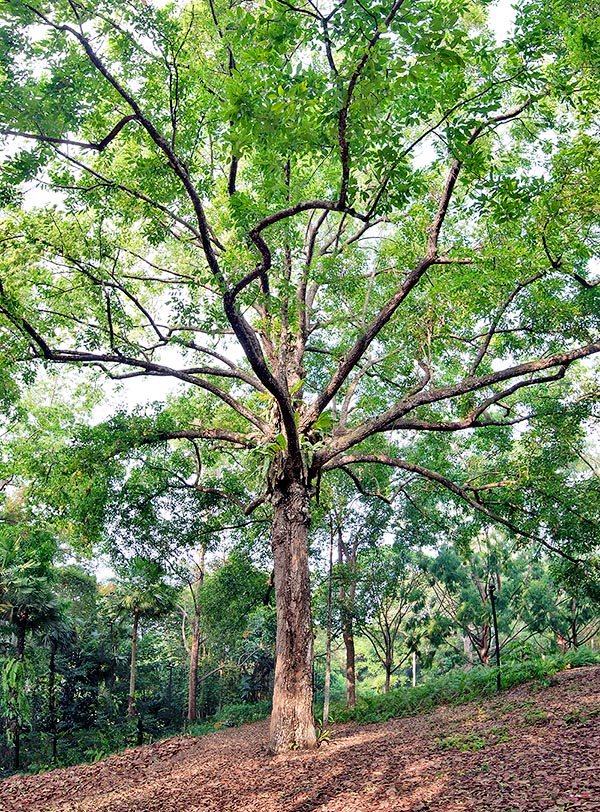Family : Dipterocarpaceae

Text © Pietro Puccio

English translation by Mario Beltramini

Diffused in the Asian tropical belt from India to Vietnam, Shorea roxburghii frequently is 40 m tall with tabular roots and trunk of even 1 m of diameter. Ruthlessly exploited for the wood and victim of deforestation, is now in the red list of the endangered species. Medicinal virtues © Giuseppe Mazza
The species is native to Cambodia, India (Andhra Pradesh, Karnataka, Kerala and Tamil Nadu), Laos, Myanmar, Peninsular Malaysia, Thailand and Vietnam where it lives in the dry evergreen or deciduous forests, at times representing the dominant species, often on sandy soils, up to about 1000 m of altitude.
The genus is honoured to Sir John Shore Teignmouth (1751-1834); Governor-General of India, the species to the English botanist William Roxburgh (1751-1815), director of the Calcutta Botanical Gardens.
Common names: talora lac tree, (English); popé:l (Cambodia); aragina mara, jaala, jaalada, jalakanda, jalari, jalla, kunjiti, sal, talura (India); khanho:m (Laos); meranti temak (Malaysia); kayom, phayom, su krom (Thailand); sến, sến bôn, sến đỏ, sến mủ, sến nghệ (Vietnam).
The Shorea roxburghii G.Don (1831) is a deciduous or semideciduous tree, up to about 40 m tall, with erect trunk, cylindrical, up to 1 m of diameter, provided at times with at the base of tabular roots (flattened roots similar to buttresses) and bark, grey-brown to brown-reddish, deeply fissured longitudinally and from whose wounds exudes a brown-coloured resin. The leaves, on a 1-3 cm long petiole, are simple, alternate, oblong-elliptic with obtuse apex and entire margin, 7-16 cm long and 3-8 cm broad, coriaceous; the young leaves are of purple colour. Inflorescences on an 8-10 cm long peduncle, axillar and panicle terminal, drooping, carrying numerous hermaphroditic flowers, of about 2 cm of diameter, of white or pale pink colour, pleasantly perfumed. Calyx with 5 ovate lobes with pointed apex of various dimensions, persistent, the three biggest ones grow when the fruit ripens forming three unequal oblong wings 4-8 cm long, corolla with 5 oblong petals, about 1,5 cm long, twisted, villous, 15 stamina and style, about 4 mm long, with trilobed stigma. The fruits, enclosed in the winged calyx, are ovoid capsules, about 1,2-2 cm long, containing only one obovoid seed 0,7-1 cm long. It propagates by seed, that must be interred as soon as possible, having a short lasting germinability, in organic loam, with addition of coarse siliceous sand per a 30%, maintained humid at the temperature of 25-28 °C; it reproduces also by cutting and micropropagation.
Tree having a certain economic importance thanks to the good quality wood, cultivable in the tropical and marginally subtropical climate zones, not bearing temperatures slightly less of 10 °C, requires full sun and is not particular about the soil, even if it prefers the fertile, draining, acidic to neutral ones. It is utilized in the reforestation of degraded areas, being resistant to dry periods and to the fire, and as ornamental due to the abundant and perfumed blooming. The wood, commercially known as “white meranti”, of cream white colour tending with the time to the yellowish brown, hard, averagely heavy and relatively easy to work, but little resistant to the atmospheric agents, is utilized in the construction of inner parts of dwellings and boats, of furniture, tools, handicrafts, in the veneering (technique consisting in covering a low-quality wood with fine sheets of prized wood) and to produce the plywood, morevover is excellent for burning. From the flowers they get an essential oil and the resin is utilized as incense; the bark is locally chewed together with the areca nuts (Areca catechu). The tree, furthermore, has a considerable religious importance in the customs and traditions of the local populations, sacred for Buddhists, its flowers are employed during the religious services.
Flowers and bark are utilized in the traditional medicine for various pathologies, laboratory studies have evidenced in the bark extracts the presence of compounds with high antioxidant power of possible interest for the official pharmacopoeia. Because of the reduction of the habitat and the overexploitation, the tree is inserted into the red list of the IUCN (International Union for Conservation of Nature) as “Endangered” (species at high extinction risk in the forthcoming future).
Synonyms: Hopea floribunda Wall. (1829); Shorea laccifera B.Heyne ex Wall. (1829); Shorea talura Roxb. (1832); Saul iallarea Roxb. ex Wight & Arn. (1834); Vatica laccifera Wight & Arn. (1834); Shorea laurifolia Wall. ex Steud. (1841); Shorea floribunda Kurz (1873); Shorea harmandii Pierre (1886); Shorea attopoensis Pierre (1890); Shorea cochinchinensis Pierre (1890); Anthoshorea harmandii (Laness.) Pierre (1891); Shorea saigonensis Pierre (1892); Shorea cochinchinensis var. saigonensis (Pierre) P.Guérin (1910).
→ To appreciate the biodiversity within the DIPTEROCARPACEAE family please click here.
